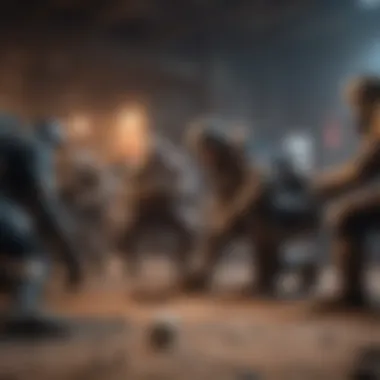Strategies and Trends in Boss Team Games


Intro
In the ever-evolving landscape of mobile and handheld gaming, boss team games have carved out a distinct niche. This genre is characterized by players uniting to take on formidable opponents, fostering a blend of cooperative gameplay and strategic planning. As gaming enthusiasts delve deeper into this world, understanding the mechanics, trends, and community dynamics becomes essential for both casual players and hardcore gamers alike.
The significance of these games lies not just in their thrilling battles but in the teamwork and camaraderie they encourage. Players must work together, utilizing each character’s unique strengths and weaknesses to devise strategies that can turn the tide in their favor. From novices to seasoned pros, each participant plays a vital role, underscoring the importance of communication and collaboration.
Through this exploration, we will dissect the integral aspects of boss team games, highlighting gameplay mechanics and community engagement. Moreover, we aim to uncover insights about the evolving trends that define this captivating segment of gaming. As we journey through various elements, readers will gain a comprehensive understanding of what makes boss team games not just fun, but also a fascinating study of teamwork and strategy.
Prelims to Boss Team Games
Boss team games have carved out a significant niche in the mobile gaming arena, combining complex strategies with the thrill of cooperative play. As players grapple with challenging adversaries, they encounter not only gameplay mechanics but also the deeper connections that form within teams. This section serves to introduce the concept of boss team games, elucidating their role in the larger landscape of gaming, particularly in mobile formats.
Defining Boss Team Games
Boss team games are characterized by group dynamics where players unite to defeat formidable bosses. These encounters require not just individual skill, but also cohesion and effective communication among team members. Unlike traditional single-player formats, these games immerse players in a shared experience, amplifying the stakes and collaboration.
Central to these games is the boss encounter itself. Typically designed to test players' skills and strategies, bosses often feature unique abilities and patterns that require teams to work in unison. Each challenge can demand a mix of roles – some players might focus on damage while others provide support or crowd control.
To put it simply, boss team games can be compared to a complex dance where each player must be in sync to create a successful outcome. Their essence lies in shared triumphs and defeats, echoing the age-old adage, "teamwork makes the dream work."
Importance in Mobile Gaming
The rise of mobile gaming has provided a fertile ground for the proliferation of boss team games. The on-the-go nature of mobile platforms enables players to connect and collaborate from virtually anywhere, thus fostering a robust community.
Why are boss team games so vital in mobile gaming? Here are a few considerations:
- Accessibility: Mobile devices have made gaming available to a wider audience. Players can easily join teams regardless of their physical location.
- Engagement: These games keep players coming back. Shared goals create a sense of belonging and mutual investment.
- Skill Development: Teams often analyze past encounters to refine their strategies, promoting learning and improvement among players.
Boss team games serve as a prime example of how multiplayer experiences can enhance player engagement, foster social connections, and ultimately enrich the gaming landscape.
In summary, the introduction of boss team games is not merely a trend in the gaming world but a reflection of the evolving demands of gamers looking for collaboration and excitement. As the article progresses, we'll dive further into the mechanics, trends, and psychology that make these games a compelling part of the gaming experience.
Mechanics of Cooperative Gameplay
The mechanics of cooperative gameplay are the lifeblood of boss team games, acting as the bedrock upon which thrilling experiences are built. Understanding how players can effectively work together not only enhances gameplay but also deepens the connection between players. In this section, we will explore the various vital aspects that contribute to successful cooperative play, focusing on the dynamics of team formations, well-defined roles, and effective communication strategies.
Forming Effective Teams
Creating effective teams is more than just gathering players; it involves curating a balance among diverse skill sets. Each player contributes something unique, whether it is strategic thinking, reflexes, or knowledge about game mechanics. Think of forming a team like assembling a jigsaw puzzle. Each piece must fit together perfectly to create an entire picture, which in this case, is overcoming a formidable boss.
Several key approaches can be applied here:
- Skill Assessment: Before diving into the challenge, players should assess their abilities. This ensures that the team can cover all necessary roles effectively.
- Player Preferences: Understanding each other's playstyle can help in creating a cohesive experience. Some players thrive on being frontline warriors, while others excel at supportive roles. Knowing who prefers what can lead to smoother interactions.
- Balancing Roles: It's crucial to strike a balance among various roles. A team with too many attackers may struggle against a boss that requires more defensive strategies or healing capabilities.
Ultimately, the effort put into team formation reflects in gameplay success. A well-formed team can go from feeling like a group of strangers to a well-oiled machine, rising up to meet challenges head-on.
Roles and Responsibilities
Roles and responsibilities in a team setting are akin to the gears in a clock, each serving a specific function to keep everything ticking smoothly. Identifying and clarifying each player’s roles is essential because it sets expectations and limits confusion during intense moments. Everyone must know their part in the greater strategy.


Common roles include:
- Tank: Often the player who can absorb massive damage. They shield other players from harm, taking on the lion's share of the boss's attacks.
- DPS (Damage Per Second): These players focus on inflicting damage. They need to be aware of their surroundings to evade attacks while maximizing their damage output.
- Healer or Support: Healers play a pivotal role by maintaining the team’s health. Their awareness of team status is critical, as they often have to make split-second decisions on who to heal.
- Strategist: This usually involves providing tactical directions. They have an understanding of the boss's mechanics and often lead the team in decision-making.
Each player must embrace their role, but also be adaptable. In real-time gaming scenarios, flexibility and communication are crucial.
Communication Strategies
Effective communication acts as the oxygen of teamwork. In boss encounters, where every second counts, seamless coordination can mean the difference between victory and defeat. Therefore, having established patterns of communication can drastically enhance team performance.
Here are some powerful strategies:
- Voice Chat: Using voice chat tools can facilitate quick sharing of information. It allows for immediate feedback and rapid response to changing situations.
- Simple Commands: Establishing a set of simple commands that indicate specific strategies can minimize confusion. For example, phrases like "Hold the line!" or "Fall back!" can cut through the noise and focus the team's efforts.
- Signal Systems: For teams without voice capabilities, developing visual signals players can communicate through in-game mechanics can bridge the gap. This might be using character movements to signal an attack or retreat.
By employing these strategies, teams can bolster their collaborative efforts, setting the framework for a more harmonious and successful experience as they tackle challenging bosses together.
"Good teamwork is like a symphony; when everyone plays in harmony, the result is truly magical."
Understanding the mechanics of cooperative gameplay not only enriches the experience but also prepares players to face the challenges that boss team games present. Building effective teams, clarifying roles, and employing sound communication methods are integral components when aiming for success in these immersive gaming environments.
Design Elements Specific to Boss Challenges
In the realm of boss team games, design elements play a pivotal role in shaping the player experience. These components not only create the vibrant worlds within which players engage but also influence how teams cooperate and strategize. Effective design enhances immersion and can make the difference between players feeling exhilarated or frustrated. Let's take a closer look at key elements that define these games.
Setting the Stage: Game Environments
The environments where boss challenges unfold can be visually captivating and thematically relevant. A well-crafted world serves not just as a backdrop but as an integral part of the gameplay experience. For instance, the desolate landscapes of Dark Souls or the haunting realms of Bloodborne brilliantly set the tone for daunting encounters.
Players often uncover environmental cues that hint at potential strategies. A jagged cliff might offer a vantage point, while a dimly-lit room could conceal hidden enemies. Thus, the design must be intentional, offering players avenues for creativity while ensuring they remain within the bounds of the gameplay rules.
Moreover, incorporating interactive elements that can change during a fight—like platforms that raise and lower—can keep players on their toes and requires dynamic teamwork. The challenge is to create a space that’s visually stunning yet practical for the various tactics teams need to deploy.
Boss Mechanics: Patterns and Strategies
Boss mechanics are crucial for building tension and excitement. Each boss should come equipped with a set of patterns that dictate their behavior. This not only allows players to learn and adapt but also encourages communication and planning within the team. For example, in Monster Hunter: World, players must observe monster movements to exploit weaknesses while coordinating attacks based on the time it takes for a boss to recover after a powerful move.
- Understandable Patterns: These patterns should be logical enough that players feel rewarded for their efforts in deciphering them. Predictability in a seemingly chaotic environment can be exhilarating.
- Unique Mechanics: Introducing special abilities or phases during a fight adds layers of complexity. A boss that transforms halfway through the battle forces players to reassess strategies and provides opportunities for more engaging gameplay.
The design of these mechanics can also usher in a sense of achievement, as players successfully navigate through increasingly challenging patterns.
Balancing Difficulty and Fun
The delicate art of balancing difficulty and enjoyment is quintessential in boss team games. Too easy, and the challenge fades; too hard, and frustration sets in. Game designers must strike a balance that keeps players both entertained and motivated.
- Progressive Difficulty: Gradually increasing difficulty can allow teams to strengthen their skills as they face tougher opponents. New players can still derive enjoyment without feeling completely overwhelmed.
- Feedback Loops: Providing feedback, such as visual cues when a boss is in a vulnerable state, allows players to time their attacks effectively. Such elements can make players feel empowered instead of defeated.
Ultimately, if players feel they are improving and that the difficulty is fair, they are likely to experience more enjoyable gameplay.
"The beauty of great game design lies in its ability to challenge players while still delivering a fun experience. When a player feels they can conquer an obstacle, that sense of victory is unmatched."
By focusing on these design elements, developers can create engaging boss encounters that captivate players and stimulate teamwork. With thought-out environments, dynamic boss mechanics, and a careful hand at balancing, the foundation is laid for memorable confrontations in gaming.


Emerging Trends in Boss Team Games
The landscape of boss team games is constantly evolving, reflecting shifts in technology, player expectations, and community dynamics. Understanding these emerging trends not only enhances the gaming experience but also offers developers and gamers a roadmap to navigate the continually changing terrain of mobile gaming. These trends innerweave an exciting fabric that shapes how teams engage with boss challenges, connect with each other, and derive value from their gaming endeavors.
Integration of Emerging Technologies
Advancements in technology are reshaping how players interact within boss team games. From augmented reality (AR) to virtual reality (VR), these innovations push the boundaries of what players experience during gameplay. Imagine teaming up to defeat a dragon not just on a screen but as if it existed in front of you, thanks to AR. This technology invites players into immersive environments that makes every battle feel more real.
Beyond immersive environments, AI-driven game mechanics are also playing a role. Developers are harnessing AI to create smarter and more adaptive boss characters, which can read player patterns and adjust difficulty in real-time. This ensures each session feels fresh, challenging, and tailored to the team’s skill level. Players are no longer just mindlessly grinding; they are engaged in a real tactical dance against sophisticated foes.
- Use of cloud gaming is another emerging trend, facilitating seamless play across devices, allowing players to join their friends without hardware restrictions.
- Micrometers of technology merge into gameplay like voice commands, enabling hands-free communications and strategic decisions that keep gameplay fluid without putting a wrench in team dynamics.
The integration of these technologies is not just about novelty; it is about enriching player experiences, making gameplay more accessible, and driving engagement.
Shifts in Game Monetization
The monetization strategies for boss team games are undergoing significant shifts, reflecting broader trends in the gaming industry. Many developers are moving away from purely pay-to-win models towards more community-focused approaches.
In-game purchases continue to offer cosmetic upgrades, making character customization appealing without disrupting the game balance. Furthermore, introducing battle passes provides a steady income stream while giving players a sense of progression. Players pay for the opportunity to unlock exclusive items as they complete challenges over a set period. This model fosters an ongoing commitment to the game while keeping monetization fair – players feel they are getting more for their investment.
Moreover, the rise of live-service games has seen developers continually add new content, keeping communities engaged long after the initial launch. This ongoing investment in the game invites players to return and experience novel challenges, thus enhancing their connection to the game and others in the community.
Part of this shift also includes ad-based monetization, where teams can earn in-game rewards for watching ads. This approach can increase player retention without the pressure of traditional monetization approaches.
Community-Driven Gameplay Evolution
At the heart of boss team games lies a vibrant community that significantly influences design and gameplay dynamics. Developers are increasingly recognizing the importance of community feedback, turning fans into allies who shape the evolution of their favorite games.
Online platforms such as Reddit and Discord serve as forums where players share strategies, tips, and experiences. These discussions often lead to crowdsourced ideas on how to improve game mechanics or suggest new bosses to include—engaging players and allowing them to feel ownership over their playing experience. It’s a two-way street, fostering loyalty and enthusiasm.
Players are also rallying around community events, where they band together to tackle challenges or compete against other teams for unique rewards. These initiatives strengthen friendships within the gaming circles, as real-world dynamics often play out in the virtual arenas of boss games.
Lastly, grassroots movements emerge, such as player-organized tournaments or charity streams, enhancing the sense of community and encouraging developers to tailor content based on participation and feedback.
As boss team games continue to evolve, these trends and community dynamics will gather momentum, inviting players and developers to explore new heights within this captivating genre.
The Psychology of Team Play
Understanding the psychology behind team play is crucial in appreciating how players engage with boss team games. It dives into the motivations, emotions, and group dynamics that unfold when players unite against common challenges. Successful cooperative gameplay goes far beyond mere mechanics; it is about forging connections among players, often leading to memorable experiences. Therefore, examining this psychological dimension offers insights into how developers can enhance gameplay and foster enduring communities.
Understanding Player Motivation
When it comes to boss team games, players are drawn in by a variety of motivations. Some seek camaraderie, hoping to connect with friends or new acquaintances as they tackle formidable foes. Others are driven by competition, aiming not only to defeat the boss but also to outperform their teammates.
Different types of players have distinct motivations:
- Social Players: They thrive on the relationships formed through teamwork. The joy of shared victories and experiences keeps them coming back to the game.
- Achievers: These are the players focused on obtaining specific rewards or completing challenges. They often motivate their teams to push through tough battles to achieve their goals.
- Explorers: They find pleasure in delving deep into game mechanics and lore. Understanding boss behaviors can become a secondary goal, enhancing overall enjoyment.
Recognizing these motivations can help game designers create environments that cater to diverse audiences, ensuring engagement across the board.
Conflict and Resolution in Teams


Conflict is an inevitable part of team dynamics, especially in high-pressure situations like facing a boss. When things don’t go as planned, tensions can rise, leading to disagreements or frustration among players. The ability to resolve these conflicts quickly is key to maintaining a positive gaming atmosphere.
There are several common sources of conflict:
- Communication Breakdown: Poor communication strategies can lead to misunderstandings. One player might believe they are attacking a specific target while others are focusing on defense.
- Role Misalignment: Each team member has designated roles (e.g., healer, tank, damage dealer). If someone strays from their role during critical moments, it may create friction within the team.
- Performance Pressure: High stakes can cause players to lash out when things go wrong. Recognizing that everyone is playing to have fun can help mitigate this discomfort.
Teams that learn to navigate conflict skillfully tend to emerge stronger. By fostering an inclusive environment where players feel safe to share their thoughts, teams can turn disagreements into opportunities for growth.
Building Resilience as a Team
Resilience in gaming isn’t just about how well a team can handle setbacks; it is about adapting to challenges and bouncing back stronger. In the context of boss team games, developing resilience is essential for long-term success.
Here are strategies that can help teams build resilience:
- Establishing Trust: Trust among team members allows for open conversations about weaknesses and mistakes, fostering a supportive atmosphere.
- Embracing Failure: Viewing failures as learning experiences rather than setbacks can enhance a team's capacity to recover. This shift in perspective encourages experimentation with strategies and fosters innovation.
- Team Celebrations: Recognizing both victories and efforts, even in losses, can bolster team morale. Celebrating small milestones encourages players to keep going, even when the going gets tough.
Teams that cultivate resilience not only enhance their chances of success but also enjoy their gaming experience more. With a strong psychological foundation, players are likely to form deeper connections, further solidifying the joy found in boss team games.
Case Studies of Popular Boss Team Games
The landscape of boss team games is not just defined by mechanics and design elements; it's significantly shaped by how players engage with these titles. Each game has its own tale to tell, showcasing what works and what doesn’t in the ever-evolving genre of cooperative play. Case studies provide valuable insights into successful strategies, mistakes to avoid, and rewards of teamwork. These games exemplify the bond between design and player experience, offering lessons that can inform future game development and community engagement.
Analysis of Notable Titles
Examining specific boss team games helps us appreciate the nuances that distinguish the memorable from the forgettable. For instance, Monster Hunter: World revolutionized cooperative gameplay by integrating systems that encouraged teamwork while also catering to individual play styles. Players must capitalize on their character's strengths, much like a well-oiled machine. The flexibility of roles—from tank to healer—creates a dynamic environment that enhances strategy.
Similarly, Destiny 2’s Raids are a masterclass in cooperation. Each player takes on a unique responsibility, forcing communication and collaboration. The thrill of overcoming a difficult boss is amplified by the connection between team members as they navigate the challenges. Here, the concept of synergy isn't just theoretical; it’s critical for success.
Community Insights and Reactions
Community feedback significantly influences the evolution of boss team games. For example, after the release of World of Warcraft: Shadowlands, many players voiced their concerns about the balance between challenge and player enjoyment. Developers took note of these sentiments, adjusting the difficulty levels based on feedback to enhance overall gameplay.
Engagement on platforms like reddit.com allows players to share tips and discuss strategies freely. Seeing how different players tackle the same boss provides a wealth of strategies and insights that promote deeper team dynamics. Players’ reactions often lead game developers to refine mechanics, emphasizing the importance of community input.
"It's not just about defeating a boss; it's about how we come together as a team to achieve that victory. That's what keeps us coming back." – Anonymous Gamer
Through these case studies, we extract valuable takeaways for future designs. The balance between challenge and accessibility, the power of communication, and the joy of shared victories are all key points. As the industry forges ahead, understanding these dynamics will be essential in crafting the next generation of boss team games.
Ending: The Future of Boss Team Games
As we peer into the horizon of boss team games, it becomes unmistakably clear that their evolution will significantly influence the landscape of mobile and handheld gaming. This genre, characterized by cooperative efforts to defeat formidable adversaries, has seen an upsurge in interest from gamers of all backgrounds, indicating the genre's relevance as it continues to grow. Developers are constantly searching for new ways to enrich gameplay while catering to the diverse preferences of players.
Anticipating Future Developments
The future of boss team games is likely to be marked by several key advancements. To start, we may witness enhancements in the integration of augmented reality (AR) and virtual reality (VR) technologies. Picture this: players physically moving through their environments, engaging with bosses that come to life in their living rooms. This could create a sense of immersion we haven’t seen before.
Moreover, AI technology is expected to take center stage. Imagine bosses smartly adapting their strategies based on players' actions, requiring teams to brainstorm and react on the fly. This automated level of difficulty could shift team dynamics significantly, pushing players to cultivate sharper skills and communication.
Game developers may also experiment with mix-and-match styles of gameplay. Think about blending RPG elements with traditional boss fights, where storyline choices influence not only the challenges faced but also the bosses themselves. Such integration could deepen player investment in their characters and the overall narrative.
In addition to technological advancements, we expect to see a greater emphasis on inclusivity and accessibility in boss team games. More developers are recognizing the importance of catering to gamers with disabilities, ensuring that everyone can join in the fun. This may include features like customizable controls or visual/sound aids.
Final Thoughts on Community Engagement
One cog in the machine of boss team games is undeniably community engagement. Players aren't just passive participants; they are essential contributors. The feedback loops established between developers and players contribute to more than just game updates; they sculpt the experience itself. Communities often ignite various events, tournaments, and discussions, fostering a vibrant ecosystem around their favorite games.
For developers, tapping into the buzz generated by these communities can serve as a pivotal strategy. Listening to player feedback leads to better-designed updates and expansions, ensuring long-lasting enthusiasm and loyalty. The beauty of this relationship lies in its reciprocity; as developers create engaging content, the community thrives, and as the community flourishes, the gaming ecosystem grows richer.







